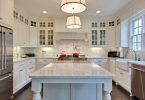 Window options for new construction offer numerous styles in a variety of materials. The most common types of window styles include these:
Window options for new construction offer numerous styles in a variety of materials. The most common types of window styles include these:
- awning
- casement
- double-hung
- gliding
- fixed
- bay
The dimensions of awning windows are usually among the smallest of any window in a home. Hinges at the top allow them to open outward. Usually a series of awning windows is placed in a row at a high point on a wall to allow light to illuminate a room and to create ventilation even during rain.
Casement windows have hinges on one side, and they open outward with a crank. The crank handle makes them easy to open when they are located above a kitchen sink or countertop.
Double-hung windows are probably the most familiar design. They open vertically, and the sash can move up or down to provide the desired amount of ventilation. A sash is the window panel that is comprised of the pane of glass and the frame that surrounds it. Double-hung windows are mounted flush with the exterior of a house, so they do not have the disadvantage of casement windows that may extend over a sidewalk when open.
Gliding or sliding windows are easier to open than windows that crank out, and they have a sleek and contemporary look. They do not project into walkways, so they are safe to use near walkways. Some small models are used below fixed glass to provide ventilation if there is no danger of children opening them when no one is watching.
Fixed glass presents a picture of the outdoor scenery, and it is often thought of as a picture window. It allows a great amount of light to enter a room, and it is a favorite choice in contemporary homes. Sliding windows that are placed below it create an architectural design that is attractive and pleasing.
Bay windows occupy a prominent focal point for interior design. They have three or more window units that project outward from the exterior. Each section faces a slightly different direction, presenting multiple views from one position inside the home. Some are designed with window seats that conform to the shape of the window.
Materials that are typically used for window construction include these:
- wood
- vinyl
- vinyl clad
- aluminum clad
Wood is traditionally used for window construction. Its insulating properties inhibit the passage of cold or heat from outside. It requires frequent maintenance to prevent rot. Vinyl windows are maintenance free, and they are available in many colors that never need painting. Vinyl clad windows use a wood frame for stability and for its insulating effect. Aluminum clad windows are similar to vinyl clad in style and function.
Latest posts by Canadian Home Trends (see all)
- Dining Room Design Tips - November 27, 2025
- Practical Luxury in Forest Grove - November 27, 2025
- The Hidden Value of Great Design - November 27, 2025






